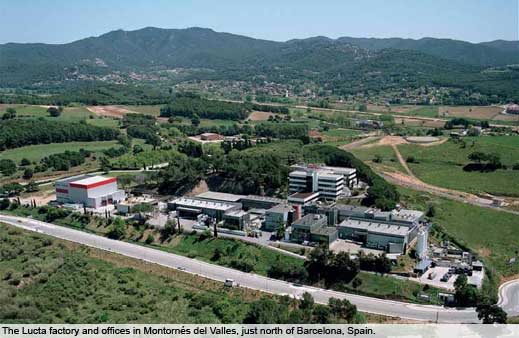Lucta makes business of senses

Feed for an animal is not always palatable. Young animals, in particular, have difficulties adjusting to processed feed after weaning. Lucta in Spain has specialised in improving the feed intake of animals by making the feed more attractive with flavours and palatability modifiers. AllAboutFeed had a tour of the facilities at Montornés del Valles, just north of Barcelona, to get to know the company better.
Lucta was founded in 1949 and has since been a family-owned company with approx. 500 employees and a turnover of €120 million. The company has a global presence with offices and/or production units in Colombia, Mexico, the US, China, Brazil and Poland. It considers its feed additives division to be a market leader in flavours and palatability modifiers in animal feed. “We try to achieve our targets through a combination of imagination, creativity and technology,” says Carlos Prada, group MD at Lucta.
Research farm
“We specialise in innovative creation,” adds Volker Altenbokum, Director of the feed additives division. This division focuses on four main additives: palatability modifiers, antioxidants, acidifiers, and mould inhibitors. These are produced in Spain, Colombia, Mexico and China, the latter being the fastest growing facility where so far only feed additives are manufactured. Besides that, there are commercial operations in Brazil, Poland and the US. “We have our own research farm, because we need to demonstrate the value of a feed additive for palatability,” Altenbokum explains. This Swine Experimental Unit is run in close collaboration with the University of Gerona. Some 400 piglets can be housed and preferences of the animals are measured in liquid and solid feeds. Also, feeding behaviour of the animals can be monitored with cameras. Calf (heifer/cow) research takes place at research and commercial operations owned by third parties, which co-operatein palatability research.
So, Lucta is a chemical company, which implies that there is a lot of laboratory work involved. Indeed, 25%-30% of the raw materials are home-produced. “This gives us more flexibility and more competitiveness,” Altenbokum adds. “And with current environmental laws we also have our own recycling section to protect the environment.”When visiting the plant it is striking how clean everything is. Also, the huge air-cleaners catch the eye. Since Lucta works with all kinds of flavours (nice and not-so-nice smelling) all outgoing air needs to be cleaned with scrubbers.
Sensation or nutritional value
Palatability – is it just a sensation (smell, taste) or does it also have a nutritional value? R&D team leader Ignacio Ipharraguerre tries to explain palatability. “It is a complex matrix of sensations and metabolic feedback from feed ingestion that involves processes like wanting, learning and liking, which ultimately affects feed intake and welfare. That is what we strive for.” Figure 1 illustrates the complexity of palatability research. An animal will subconsciously rememberthe feed it ate. If it was beneficial and tasteful, it will eat more, but if the taste was not so appealing, it will eat less.
“We believe that a flavour definitely has a value for managing nutrition. After weaning, piglets often have difficulties eating enough solid feeds. If a flavour added to the feed can increase feed intake it certainly has value. We have enough research to back this up,” says Ipharraguerre.
The research programme for increasing Lucta’s knowledge base focuses on five main subjects:
1. Palatability of ingredients (sensorial cues)
2. Taste physiology (taste receptors)
3. Neurophysiology (hedonism)
4. Feeding behaviour (welfare)
5. Gut functionality (nutrient digestion).
Ingredient palatability is studied in pigs, cattle and sheep. “We have developed animal models and try to explain what the animal’s feed preferences are. For example, pigs prefer rice as a raw material, but like dehulled oats the most (see Figure 2). Cattle prefer wheat as a starch source. Why is that? If we can discover these answers then we are able to manipulate sub-standard ingredients so that the animal will eat them,” Ipharraguerre explains.
Regarding taste physiology, in vitro and in vivo models are used. There are five tastes recognised: sweet, sour, salty, bitter, and umami (savoury, taste of protein). “The ingredients are there, but the basic problem is that the young pig which has just been weaned, does not eat enough. We found that the umami aspect is more relevant to piglets than sweeteners, so we question how feed intake can be improved by adding the umami aspect to the feed.”
Lucta focuses primarily on young animals for their flavours and it is assumed that chicken give more attention to physical aspects like particle size and colour than taste. Therefore, research in broilers is aimed towards gut functionality. The effects of essential oils, which are also flavours, as well as the effects of phenylpropanoids are researched. These are ingredients that give the spicy hot taste, such as capsicum. Those additives influence enzyme activity and bile production and thereby affect digestion and microbiota inhabiting the gut.











